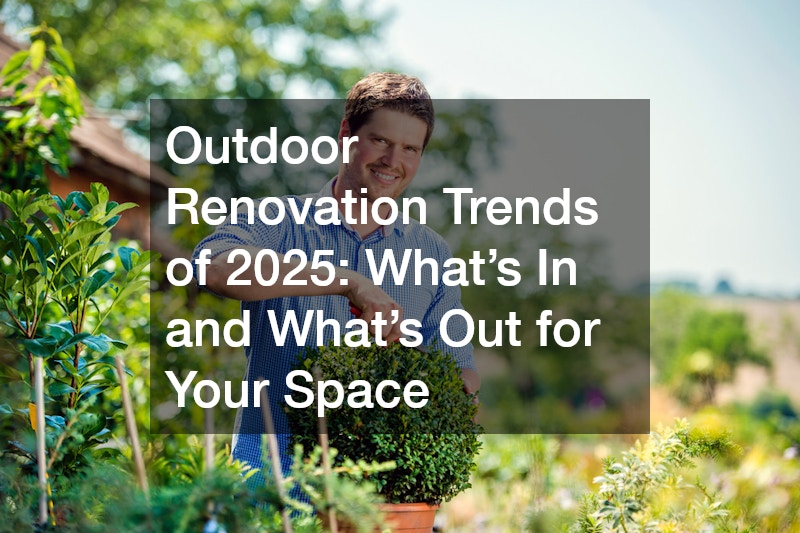Outdoor renovations are evolving as homeowners increasingly seek to create spaces that are functional, sustainable, and stylish. In 2025, we will see a shift toward designs that emphasize versatility, comfort, and connection to nature. This article explores the key trends that are emerging in outdoor renovations for 2025, detailing what’s in and what’s out for your outdoor space.
The Evolving Outdoor Renovation Landscape
As we approach 2025, the focus of outdoor renovations is shifting from traditional designs to more innovative, environmentally-conscious solutions. In the past, outdoor spaces were often an afterthought, with minimal consideration given to how they functioned in daily life. Today, outdoor living areas are becoming an extension of our homes, reflecting our values and lifestyle preferences.
Trends are moving toward creating spaces that blend form and function seamlessly. Homeowners are looking for ways to enhance their outdoor spaces by introducing eco-friendly materials, smart technology, and multi-functional features. As we examine the trends shaping outdoor renovations in 2025, we will also look at what’s being left behind.
1. In: Sustainable and Eco-Friendly Materials
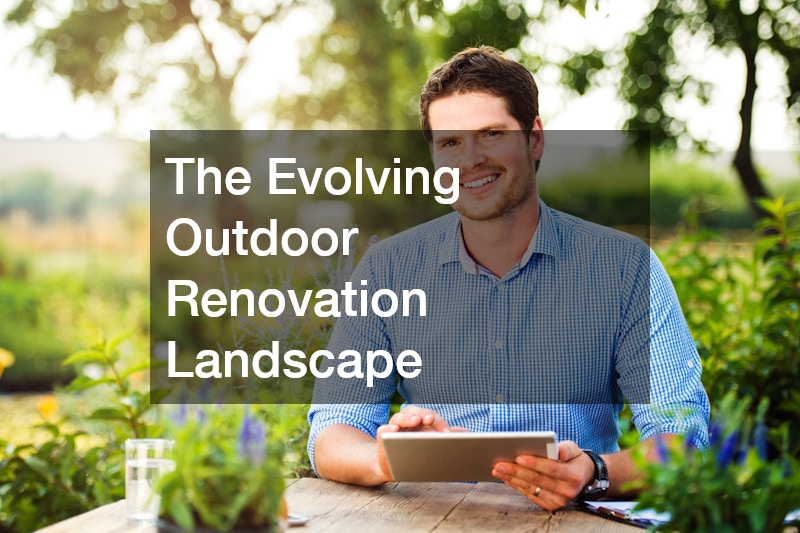
In 2025, sustainability is at the forefront of outdoor design. The use of eco-friendly materials is not just a trend; it’s a necessity for homeowners who want to reduce their carbon footprint and contribute positively to the environment. Sustainable materials are being incorporated into every aspect of outdoor spaces, from decking and fencing to furniture and flooring.
Recycled and Renewable Materials
One of the most notable materials gaining popularity is reclaimed wood, which is both sustainable and stylish. Recycled plastic and composite decking materials are also making waves for their ability to mimic natural wood without the environmental impact. Bamboo, another renewable resource, is being used for a variety of outdoor features, including fencing, decking, and even outdoor furniture. These materials not only help conserve natural resources but also offer long-lasting durability, making them ideal for outdoor use.
Benefits of Sustainability
The use of sustainable materials goes beyond just reducing environmental impact. These materials are often low-maintenance, which means they can save homeowners time and money in the long run. For instance, composite decking requires less upkeep than traditional wood, which may need regular sealing or staining. Furthermore, these materials often come with warranties, offering peace of mind that they will last for years without significant deterioration.
2. Out: Overly Synthetic Materials
While synthetic materials have been popular in outdoor design, 2025 will see a shift away from overly synthetic options. In the past, materials such as plastic-based decking, faux stone veneers, and non-biodegradable finishes have been used to imitate natural textures. However, these materials contribute to pollution and waste, making them less desirable in today’s eco-conscious market.
Environmental Impact
Synthetic materials, especially those made from PVC and other plastic derivatives, are not biodegradable. As these materials break down over time, they can contribute to pollution in the environment. Additionally, the production of synthetic materials is energy-intensive and often involves the use of harmful chemicals. This makes them a less sustainable option compared to natural materials like wood, stone, and metal.
Aesthetic Shift
Another reason for the decline of synthetic materials is that they often lack the authenticity of natural materials. Homeowners are increasingly seeking textures and finishes that feel real and organic. This shift toward natural aesthetics is driving the demand for materials like reclaimed wood, natural stone, and clay, which offer a more authentic, timeless appeal for outdoor spaces.
3. In: Multi-Functional Outdoor Spaces
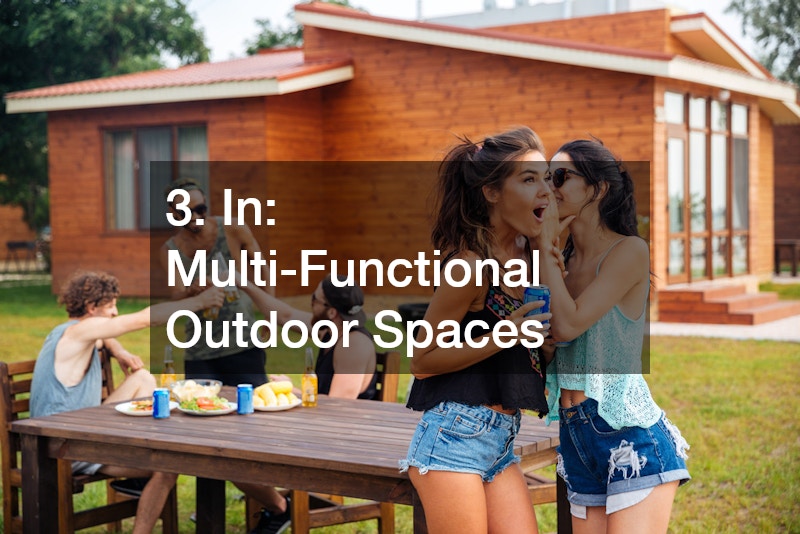
Multi-functional outdoor spaces are one of the most significant trends for 2025. As homes become smaller and more compact, homeowners are looking for ways to maximize every inch of available space, including their outdoor areas. Creating spaces that serve multiple purposes, such as dining, relaxing, and entertaining, is essential for homeowners who want to make the most of their property.
Versatility for All Activities
Outdoor spaces are being designed to accommodate a wide range of activities. For example, many people are incorporating outdoor kitchens, dining areas, and fire pits into a single space. The goal is to create areas that can easily transition from a casual family meal to a lively evening of entertainment. Features like retractable screens and adjustable seating arrangements allow the space to be flexible for different occasions. Additionally, using durable surfaces for walkways or driveways can provide a solid foundation for a variety of activities. Asphalt paving is a reliable option that offers both functionality and a sleek, modern look. Multi-functional spaces provide homeowners with the opportunity to enjoy the outdoors without compromising on style or comfort.
Tips for Maximizing Small Spaces
For those with smaller yards, multi-functional design is particularly important. Consider incorporating vertical gardens or hanging planters to add greenery without taking up valuable floor space. Modular furniture that can be rearranged or folded away is another great way to ensure the space works for both everyday use and larger gatherings. Multi-functional spaces provide homeowners with the opportunity to enjoy the outdoors without compromising on style or comfort.
4. Out: Overly Segmented Yard Layouts
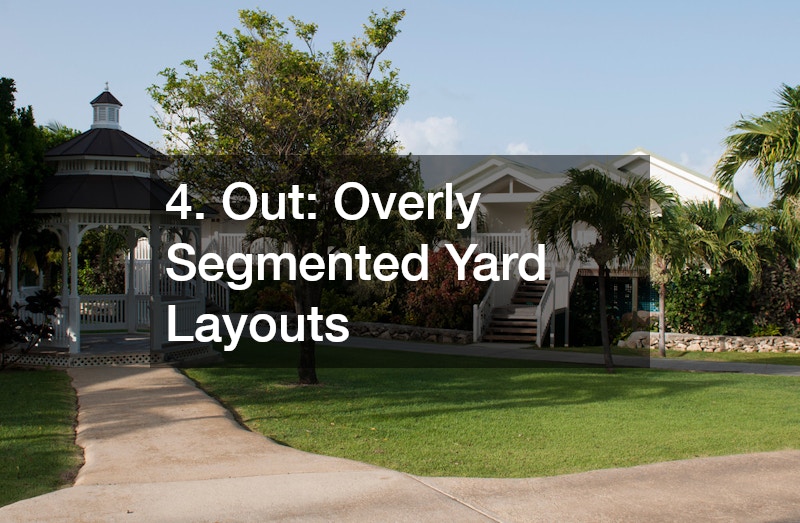
Gone are the days of rigid, compartmentalized yard layouts. In 2025, open, flowing spaces that seamlessly blend different zones are taking the place of segmented designs. Overly segmented yards often feel disjointed and can limit the functionality of the space. Instead, the trend is toward creating fluid transitions between different areas, allowing for a more cohesive and harmonious design.
The Decline of Rigid Boundaries
Rigid fences, defined walkways, and strict boundaries between sections of the yard are being replaced by more organic layouts. Homeowners are opting for curved lines, integrated landscaping, and natural materials that make the space feel more expansive and connected. The emphasis is on creating a sense of openness, where different zones flow into one another effortlessly. Landscaping pavers are a great option for these fluid layouts, offering both visual appeal and a practical solution for creating smooth transitions between spaces.
The Appeal of Open Spaces
An open layout allows for greater flexibility in how the space is used. For example, an outdoor dining area can easily transition into a lounge space, or a garden area can connect with a patio without feeling like two separate parts. This type of design encourages people to move freely between spaces, promoting a more interactive and engaging outdoor experience.
5. In: Smart Outdoor Technology
Smart technology is no longer confined to the inside of the home. In 2025, outdoor spaces are becoming smarter, with the integration of devices that enhance convenience, security, and energy efficiency. From automated lighting systems to smart irrigation systems, homeowners are looking for ways to bring the latest tech innovations to their outdoor areas.
Automated Lighting and Irrigation
Smart lighting is one of the most popular outdoor technologies. These systems can be programmed to turn on and off at specific times, creating an ambiance that suits any occasion. Motion sensors can also be added for added security. Similarly, the smart irrigation system is becoming a staple in sustainable outdoor design. These systems use weather data to adjust watering schedules, ensuring that plants get the right amount of water while conserving resources.
Energy Efficiency and Convenience
Homeowners are also using solar-powered devices to reduce their carbon footprint. Solar-powered garden lights, water features, and even smart outdoor appliances are gaining traction. These energy-efficient solutions help homeowners enjoy the outdoors without worrying about high utility bills or environmental impact.
6. Out: Overuse of Traditional Lawn
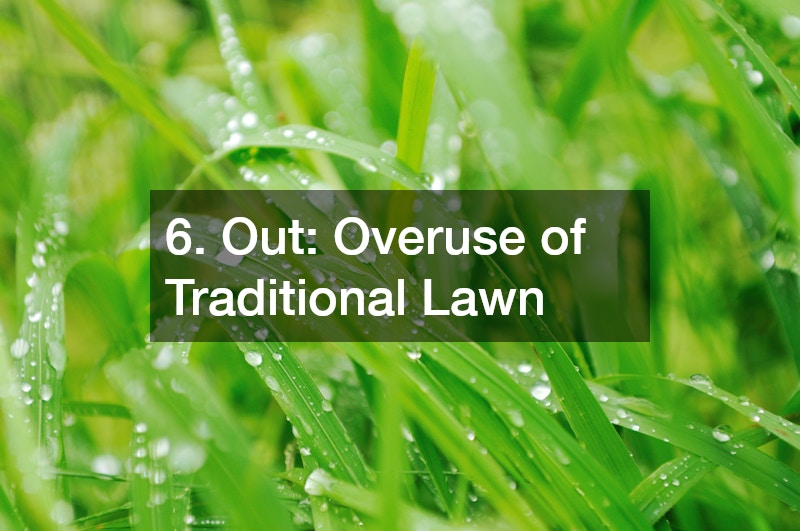
The traditional lawn is quickly becoming a thing of the past. With increasing concerns about water usage, maintenance costs, and the environmental impact of pesticide use, homeowners are turning away from large, water-hungry lawns in favor of more sustainable landscaping options.
Water-Hungry Lawns
Maintaining a lush, green lawn requires a significant amount of water, which is becoming unsustainable in many regions, especially in areas prone to drought. Lawns often require regular mowing, fertilizing, and pest control, all of which contribute to environmental degradation. As a result, more homeowners are opting for low-maintenance alternatives that require fewer resources to maintain.
Sustainable Alternatives
Xeriscaping, the practice of using drought-tolerant plants and efficient irrigation methods, is a growing trend. Native plants, which are better adapted to local climates, are also gaining popularity. These sustainable landscaping options not only conserve water but also reduce the need for harmful chemicals and fertilizers.
7. In: Biophilic Design Elements
Biophilic design, which seeks to connect people with nature, is gaining momentum in outdoor renovations. By incorporating natural elements like living walls, green roofs, and water features, homeowners can create relaxing environments that promote well-being.
Living Walls and Green Roofs
Living walls, also known as vertical gardens, are a great way to introduce greenery into urban spaces. These walls can be planted with a variety of plants and are perfect for adding beauty and functionality to small spaces. Similarly, green roofing, which is covered with vegetation, not only enhances the aesthetic of a home but also provides insulation, improves air quality, and supports local wildlife.
Water Features and Relaxation
Water features, such as fountains, ponds, or waterfalls, are another essential part of biophilic design. The sound of flowing water creates a calming atmosphere, making it ideal for outdoor spaces designed for relaxation. These features can be customized to suit any outdoor environment, from small courtyards to large garden areas.
8. Out: Cookie-Cutter Designs
Cookie-cutter designs, which rely on generic, mass-produced elements, are being replaced by more personalized and unique outdoor spaces. Homeowners are increasingly seeking custom designs that reflect their individual style and needs. The trend is toward creating outdoor spaces that feel authentic and tailored to the homeowner’s lifestyle.
Personalized Outdoor Spaces
Instead of relying on off-the-shelf furniture and decor, many homeowners are opting for custom-made items that add a personal touch. This includes custom-built furniture, unique art pieces, and landscaping that reflects the homeowner’s tastes. The goal is to create a space that feels one-of-a-kind and truly represents the people who live there.
The Appeal of Uniqueness
Custom landscape designs are becoming increasingly popular, as homeowners seek layouts and plant selections that suit their tastes and lifestyles. Whether it’s a thoughtfully designed garden with native plants, an intricate water feature, or creative hardscaping elements like stone pathways, the emphasis is on creating a visually striking and functional outdoor environment. This personalized approach makes the landscape not only a place of beauty but one that feels tailored to the homeowner’s individual needs and desires.
9. In: Outdoor Entertaining Spaces with a Focus on Comfort
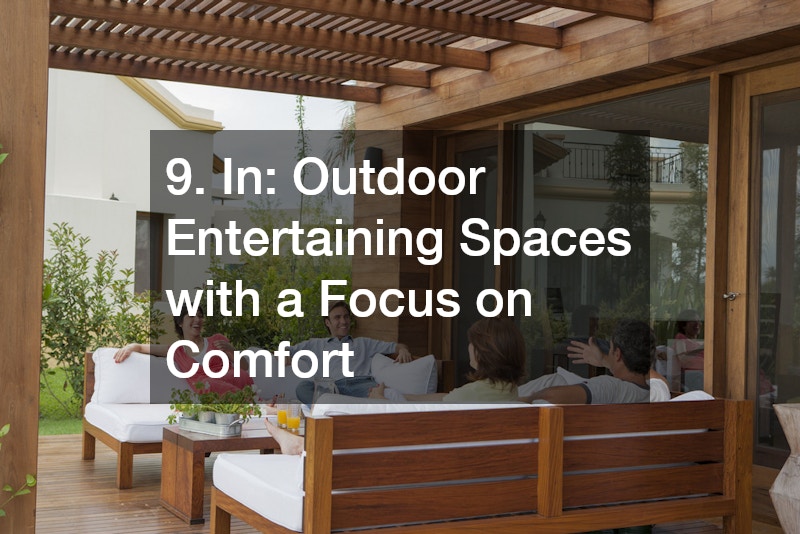
In 2025, outdoor entertaining spaces are becoming more focused on comfort and relaxation. While outdoor kitchens and fire pits remain popular, the trend is moving towards creating cozy, inviting environments where guests can unwind and enjoy each other’s company.
Cozy Outdoor Lounging
Comfortable seating is at the heart of this trend. Soft, cushioned seating options like outdoor sofas, lounge chairs, and even hammocks are being incorporated into outdoor spaces. The focus is on creating a welcoming atmosphere where guests can relax and spend time together, whether they are enjoying a meal, having a conversation, or simply lounging by the fire.
Year-Round Entertaining
To make outdoor entertaining spaces usable year-round, many homeowners are adding features like outdoor heaters, pergolas with retractable roofs, and weather-resistant furniture. For those seeking added privacy and comfort, a covered deck enclosure is becoming a popular feature. Additionally, hardscaping services are being utilized to enhance the layout and design of these spaces, with features such as elegant stone paths, built-in seating, and fire pits that elevate both functionality and aesthetics.
10. Out: Overly Elaborate Landscaping
While elaborate landscaping designs with intricate details and excessive ornamentation were once the norm, they are now being replaced by simpler, more natural designs. Homeowners are moving away from overly complex landscaping in favor of designs that prioritize ease of maintenance and a more organic look.
The Decline of Excessive Ornamentation
Excessive ornamentation, like overly manicured shrubs and intricate garden features, is being replaced with more naturalistic landscapes. Instead of sculpting plants into rigid shapes, the trend is toward allowing them to grow freely, with careful placement and pruning that emphasizes their natural beauty. For example, shrub removal is becoming a common practice to eliminate overcrowded or overgrown shrubs, opening up space for more organic landscaping features. Homeowners are also turning to tree services to ensure that their trees are well-maintained and naturally shaped, contributing to a more harmonious, low-maintenance landscape.
Embracing Minimalism
Minimalist landscaping is gaining popularity, with clean lines, open spaces, and fewer, carefully chosen elements. This type of design reduces the time and effort required for upkeep while creating a serene, uncluttered environment. The focus is on quality over quantity, with a few standout features, such as a unique water feature or statement tree, becoming the focal point of the space.
In Closing
As we approach 2025, outdoor renovation trends will continue to evolve, driven by a desire for sustainability, comfort, and personalization. By embracing these new trends, homeowners can create outdoor spaces that are not only functional but also environmentally friendly, stylish, and uniquely their own. Whether it’s through the use of eco-friendly materials, smart technology, or biophilic design elements, the outdoor spaces of the future will reflect a more connected, comfortable, and sustainable way of living.
